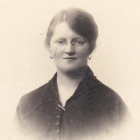Lukomski on Cameron - Part Three
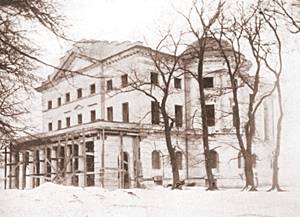 Left: Batourin during restoration work in 1911
Left: Batourin during restoration work in 1911
The architects of the eighteenth century designed the furniture as an inseparable part of their architectural schemes. Couches, easy-chairs and other articles were made to correspond with the style of mantelpieces, ceilings and the general treatment of an interior for which the architect planned the complete arrangement. Even for so exalted a patron as Catherine the Great it was not possible to alter the furniture according to her own taste or to adopt the advice of anyone else, without ruining the effect, once she had entrusted it to a Cameron or a Quarenghi. The artist chosen by her immediately became the dictator of the whole scheme. This, however, was not so much the case with Paul I and the Grand Duchess Marie. Without consulting Cameron, they made many purchases while travelling incognito in Europe, under the name of Comte et Comtesse Du Nord. It followed that Cameron, working almost simultaneously both at Tsarskoe and Pavlovsk, found a different reception in each of these Imperial palaces. Brenna also filled the rooms~ already carried out under Cameron's direction, with furniture from other sources, some bought in Paris, and the effect was spoilt, while at Tsarskoe, where Catherine left Cameron a free hand, he produced undisputed masterpieces in every detail.
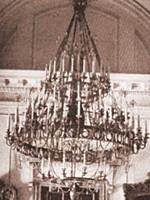
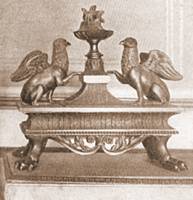
Above: Left, chandelier from the Billiard Hall of the Alexander Palace; right: fire-dog with griffons, gilt bronze from the Blue Drawing Room, Catherine Palace.
Gradually Cameron succeeded in educating and instructing the Russian cabinetmakers, and they produced masterpieces as fine as those brought from Paris or elsewhere. The works of these craftsmen took their places in all the apartments of Catherine, in the Agate Pavilion, in the Colonnade, and on the terraces.
The ateliers for Imperial bronzes, especially under the direction of Charlemagne, brought out the qualities of this noble material, and the National Manufacture (the Shpalernaia Fabrika) turned out tapestries after the Beauvais style. Cameron personally directed the work and was assisted by the cabinet-makers Scliponholz, Schtalmeyer Kilmel and Brill (or Brullo), who specialised in the work of gilding. Minciacchi and Kesa collaborated in the stonework at the Imperial Factory at Peterhof (Granilnala Fabrika). The Painting was done by Danilo Fedorov, and the wrought-iron work was forged by Bassell.
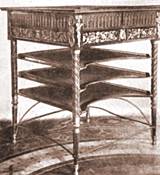
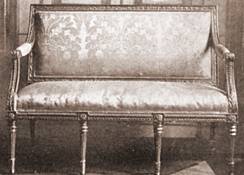
Above: Left; Catherine's secretaire; right; a settee, Catherine Palace, Cameron's Design.
For the rooms decorated in glass, faience and stone, red agate, green jasper and native marbles were brought from the country, or Finland and Korelia. The furniture at Pavlovsk was somewhat heavy in design, of an accentuated Louis XVI style. The arm-chairs and sofas may perhaps be compared with the first period of Georges Jacob. Truly imposing is the Imperial character of the objects which remained to the last in the Blue Cabinet, the Silver Cabinet, the Red Cabinet and the Bedroom at Tsarskoe. The upholstery was invariably of white silk, slightly tinted. The furniture in mahogany or rosewood harmonised excellently with the tapestries of vivid colours, violet or blue. The consoles were fitted with green or yellow marble tops, and everything accorded perfectly with the general decorative scheme. Leaf gold, in three or even four tones - rose, green, or nearly as pale as silver-covers the festoons and other ornaments, harmonising With the blue or violet of the walls.
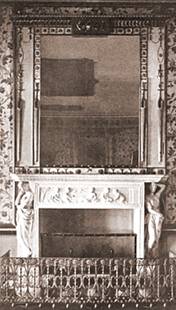
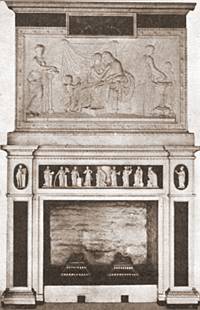
Above: Left; mantelpiece in the Blue Room, Catherine Palace; right; chimneypiece from the Agate Pavillion.
Special furniture was also designed for the Cameron Gallery, particularly large candelabra in carved wood. On the open terraces were small folding arm-chairs in wrought-iron, designed by Cameron after the Greek style, as also were the stools of the Grecian Hall at the Pavlovsk Palace. The furniture of the Gallery, reserved for State banquets, was simple but imposing, and very decorative on account of the fine quality of the wood. in contrast, the furnishings in the Agate Pavilion were carried out in marble and bronze, and particularly fine were the vases of Ural stone, of porphyry, jasper, malachite, labradorite and lapis-lazuli which decorated the walls and the entamblatures. Much of the sculptural work was executed by Rachette, as his taste agreed with Cameron's, for both men were inspired by Clerisseau, and influenced by the ancient Greek styles.
The baths in the Agate Pavilion were largely carried out in white marble, with taps in gilded bronze, all adapted from Roman models. The furniture harmomised with the enormous vases. The stools, couches, etc. of the Blue room are the most characteristic, made in the same style, of the same material and in the same colour as the walls in these little rooms. The objects brought together in the Cameron Gallery and more recently pronounced as undoubtedly his work, make up a noteworthy part of what may be justifiably called this Cameron Museum, composed of his architectural and decorative work as well as his furniture.
 Left: Wall Lantern, Catherine's Bedroom, Catherine Palace.
Left: Wall Lantern, Catherine's Bedroom, Catherine Palace.
Decorative art flourished in Russia for centuries, expressing itself both in wood and in metal relief. The principal doors of many churches were made of wood, covered with plates of gilded metal. Gilding and splendour characterised the interior decoration of seventeenth century palaces, and this Russian taste prevailed to the end of the eighteenth Century despite the influence of Italian and English architects. Under Elisabeth, Rastrelli had created the Russian Rococo style, decorating the apartments with an almost Oriental wealth of ornament, chiefly in carved wood (lime, for preference), of which hundreds of brackets, candelabra and chandeliers were made for the Tsarskoe Great Palace. Bronze foundries did not exist in Russia at that time, but once established by Catherine in 1765-1770 and directed by Charlemagne, they soon began to make, along with bronze sword-hilts and other arms, fireplace furnishings, grates, fire-irons, and various other objects, even to the smallest, all worked with great care and taste, many of them cast and chased after the designs of Cameron. The ornament was sometimes in the Louis XVI style, though treated rather in the Adam manner. The bronze parts of the decoration of rooms, in blue and mauve, blend wonderfully with the Wedgwood medallions on a background of glass-covered walls. Chandeliers, candle-brackets and bronze-decorated lamps also constitute a Russian speciality. Very large and beautiful chandeliers were hung in Catherine's apartments, as also in the Alexander Palace at Tsarskoe. Their Russian originality is shown in a characteristic lustre of coloured glass, red, deep blue or turquoise, shaped like an elongated pear or a bottle. Such dash of colour gives them an incomparable beauty.
A quantity of small lamps and candlesticks with marble pedestals, and hundreds of cressets and candelabra filled the apartments, all with an individuality of their own. Huge lamps, enriched with rock-crystal, adorned Catherine's bedroom; the great candlesticks in the Agate Pavilion are in the form of marble goddesses bearing bronze candelabra, and even the smallest details of bronze work, such as bathroom taps, are charming.
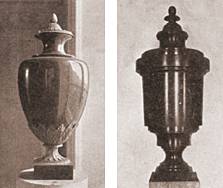 Right: Large decorative vases of porphyry, Agate Pavillion.
Right: Large decorative vases of porphyry, Agate Pavillion.
After Cameron, too, were made the marvellous heads of bulls and sheep, bound with garlands and laurel crowns which decorate like rosettes the frames of the doors and the plinths and friezes of the Salon de Lyon. In these and in the locks, keys and door-handles, as also in the bronze capitals of the Corinthian columns in the Agate Pavilion, we recognise the hand of Cameron.
The flourishing state of bronze-founding in the years between 1780 and 1800 was due to Cameron, but only a while longer did the foundries continue to produce bronzes. French competition (Thomire and others) made it preferable to purchase everything in Paris. Yet, in Cameron's time, one can establish a period of Russian bronzes made in the Enslish taste, doubtless under his influence. The foundries of the Duke of Leuchtenberg, of Yakovlev, and, above all, the Imperial Foundries, continued to produce clocks, chandeliers and lamp-brackets. Though the style may partly have been borrowed from preceding artists, like Rastrelli, the character of the ornament was no longer French: the laurel-leaf scarcely appeared, especially in candelabra, and rather hard, slender designs, sometimes engraved or chased , took the place of the Rocaille style of Louis XV, which gradually disappeared. The oak-leaf, too, often took the place of the acanthus. The narrow ribband, the "meander" which runs the length of the frieze, the "triglyph" and the ornament of the "metope," are all made of well-gilded bronze. A speciality of Cameron's is a marble statue holding a bronze girandole in the hand. This union of marble and bronze is very Russian and, at the same time, very characteristic of Cameron. So lavish became the use of bronze that Corinthian capitals entirely of bronze were set upon porphyry or agate columns.
Fire grates are particularly remarkable for the delicacy of execution and reveal an extraordinary variety of subject and wealth of fancy, showing griffons, sphinxes, lions, tigers, fantastic birds and dragons, sometimes revealing a slight Chinese influence. Especially charming are the fireplace appliances in the form of vases set upon sphinx's heads. Walls, covered with pottery or porcelain, are further enriched with bronze garlands, eagles and other birds, recalling the themes of Raphael's frescoes and the stuccoes in the Roman tombs. Cameron's individuality here loses a little under the influence of well-defined Roman motives, but the interpretation of these in bronze gives them that personal accent which characterises Cameron's work as an architect. Parts of cornices, sometimes even ovolos, in bronze, combined with other materials, reveal that force and audacity which only a great very master, as was Cameron, can permit himself to introduce into his work.
Cameron, like Robert Adam, has shown remarkable talent, amazing imagination and a wonderful insight into antiquity through the prism of the eighteenth century. His triumph at Tsarskoe was followed by his magnificent success at Pavlovsk, all of which has definitely fixed his glory in the History of European Art, of a real classical architect. Yet, while numerous volumes have been written on the work of R. Adam, or C. Wren, or so many others, Cameron has had no recognition until 1900, when a small group of enlightened amateurs in Russia brought him to light, and later, in 1917 or 1918, published articles devoted to him.
A great Scottish Architect, who has left abroad so much expression of his genius and an exquisite example of the expansion of British Taste and British Art, all the more deserves appreciation, as he deserved a better lot, and at least a grateful memory. Catherine alone, great Patron of Art and great Empress, was able to discover and appreciate this poor, lonely, yet delighted Cameron. His life and work have not been easy, but he erected a monument to himself, the only building ever to have been named after its architect, one of his many masterpieces, the Cameron Gallery, at Tsarskoe.
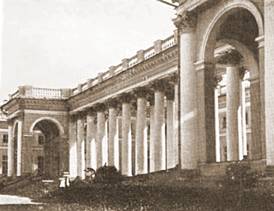
Above: After Cameron, the Alexander Palace by Quarenghi.
Please send your comments on this page to Bob Atchison
